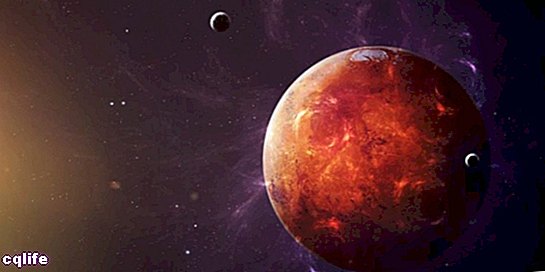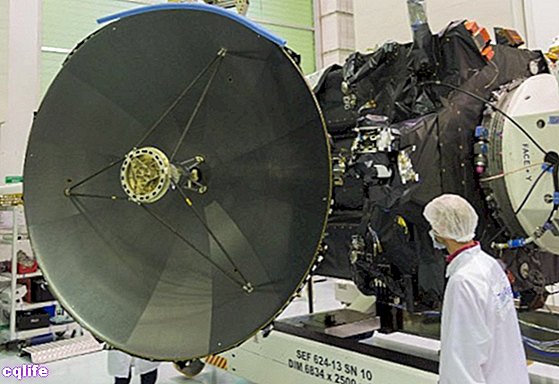- What is Mars?
- Mars Features
- Mars temperature
- Structure of mars
- Atmosphere of mars
- Life on mars
- Space exploration on mars
We explain everything about the planet Mars, its temperature, structure and other characteristics. Also, the different missions that explored it.

What is Mars?
Mars is the second planet smallest of Solar system and fourth in order of distance from Sun. Has a surface solid, dusty, cold and desert. Its name comes from Roman mythology, in homage to the god of war (The reddish color of its surface represented the blood spilled in battles).It is also known as "the red planet" and can be seen from the Earth.
NASA has evidence of 57 meteorites that could be coming from Mars and that they impacted with the Earth in diverse moments of the history. The samples obtained from the space missions are constantly compared with the materials found in the I usually land.
The following three meteorites are considered to be the largest to contain indications of molecules natural organic materials from Mars: ALH84001 (meteorite found in 1984 in Antarctica), Nakhla (meteorite found in 1911 in Egypt) and Shergotty (meteorite found in 1865 in India).
Mars Features
The diameter of Mars is about half that of Earth.Mars has a orbit elliptical, like the Earth, so the position and distance between the two planets is not always the same. On average, Mars is 230 million kilometers away from Earth. The furthest it was, according to scientific calculations, was 402 million kilometers and the closest was 57 million kilometers away.
The red planet takes 2 Earth years to make the movement of translation and 24 hours and 37 minutes to do the rotation movement. Another similarity with the terrestrial planet is the degree of inclination of its axis, of 25 degrees (against 23.4 degrees of the Earth).
It has a diameter of 6,780 kilometers (almost half that of the Earth) and is 228 million kilometers away from the star bright.
Mars is characterized by its well-differentiated climatic seasons, polar caps, valleys, cannons and volcanoes, like the Valles Marineris (a system of canyons that spans a vast territory Of the surface).
In addition, on Mars there is Mount Olympus, the largest volcano in the Solar System so far detected, which is three times higher than Everest, the Mountain largest on Earth.
It has two small satellites, Phobos and Deimos, which were discovered in 1877. They are characterized by having little mass and a poorly defined ellipsis shape due to the slight force of gravity they possess, which does not allow them to acquire a spherical shape like most of the moons in the Solar System.
Phobos is the satelite largest and scientific calculations estimate that it will hit the red planet in about 50 million years.
Mars temperature
The temperature of Mars oscillates between 20 º C and -140 º C. These large differences in temperature are due to the fact that the atmosphere it is too light to hold the heat it receives from the Sun.
That contrast between the weather day and night causes very strong winds that can trigger dust storms. Once the storms subside, it can take months for all the dust to settle.
Structure of mars
Iron oxide is abundant on the surface of Mars. (Credit: NASA)Mars is a rocky planet with a crust that ranges between 10 and 50 kilometers deep in which minerals, such as silicate, and nutrients such as magnesium, sodium, potassium and chlorine are abundant (characteristic of terrestrial soils that allow the growth of plants).
The color reddish is due to iron oxide that is abundant on the surface. At a greater depth, iron predominates and in its dense nucleus there are various metals like iron, nickel and sulfur.
Its surface of Mars bears many similarities to the relief terrestrial like volcanoes, impact craters, crustal movements, and atmospheric conditions (such as dust storms) that characterize the Martian landscape.
It does not have a global magnetic field, but areas of the crust in the southern hemisphere are highly magnetized and could be traces of a larger magnetic field, dating back about 4 million years.
According to the results of various explorations, scientists argue that Mars may have had a watery past with ancient river networks, deltas and lakes and even that the planet may have experienced major floods about 3.5 billion years ago.
Currently it is confirmed that there is water on the red planet, but the atmosphere is too thin for the Water stay in liquid state Over the surface.
Atmosphere of mars
The atmosphere of Mars is thin and tenuous, so it does not offer much protection against meteorite impacts, asteroids or kites. It is 90% composed of carbon dioxide and to a lesser extent by nitrogen and argon.
The water steam it is scarce, although enough so that some clouds and fogs of slight consistency, similar to those that are on Earth, form. However, no precipitation is formed by the conditions of Pressure and temperature.
Life on mars
Scientists argue that in order for it to be found life in a celestial body there must be the availability of water in a liquid state. Evidence from space missions shows that Mars had a vast ocean in the northern hemisphere, about 4.3 billion years ago (which could have existed for 1.5 billion years).
That watery past together with a denser and more consistent atmosphere could have been favorable conditions for the development of life. Currently, the presence of living beingsInstead, signs of past life are being investigated in times when the red planet was warmer, covered with water, and presented conditions conducive to the development of life.
Space exploration on mars

Mars is one of the most explored celestial bodies in our Solar System, due to its proximity to Earth. There are records (dating back more than 4,000 years) that the Egyptians captured the path and movements of the red planet.
The first spacecraft sent to Mars was Mars 1, which managed to fly over a distance of 193,000 kilometers without obtaining information from the planet. In 1965 the Mariner 4 space probe was launched, which managed to carry out the first transmission of data.
In 1969, the Mariner 6 and 7 missions made it possible to observe the craters of Mars, which had similarities to the Earth's satellite. Finally, in 1971 Mariner 9 was the first probe that could be placed in the Martian orbit and that was able to monitor an immense dust storm, among other relevant data.
Currently, NASA has two landers on the Martian surface and three spacecraft in orbit:
- Mars Reconnaissance Orbiter
- Mars odyssey
- MAVEN
ESA also has a lander in a zone of plain plane and two space probes in the orbit of Mars:
- ExoMars Trace Gas Orbiter
- Mars Express
Both NASA and ESA have plans to send new missions during 2020 to learn more about the planet and especially to corroborate scientists' suspicions that billions of years ago Mars was much wetter and warmer, with a thicker atmosphere.
